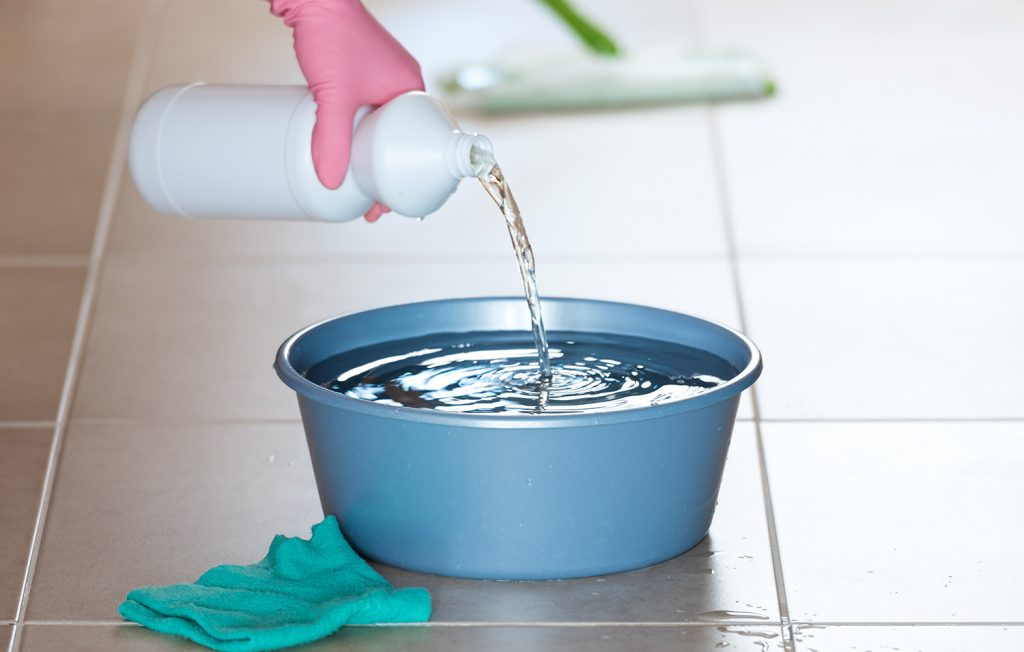Bleaching agents are materials that lighten or whiten a substrate (for example, a fabric or hard surface) through a chemical reaction. They are used for textile, paper and pulp bleaching, laundry, and many other cleaning applications. Bleaching usually involves either oxidative or reductive reactions that decompose stains and soils. These processes may involve the removal or change of larger molecules and color-bearing groups in the stain or soil into smaller, more soluble units which are more easily removed in the cleaning process. The most common bleaching agents generally fall into three categories: halogen bleaches and their related compounds (such as sodium hypochlorite and sodium dichloroisocyanurate), oxygen bleaches (such as hydrogen peroxide and sodium percarbonate) and reducing bleaches.

Halogen Bleaches
Halogen bleaching agents, mostly based on chlorine or bromine, are the most cost-effective bleaching agents. Besides being very effective at removing stains and soils, they are also highly effective antimicrobial products – indeed, water treatment is the largest use of chlorine‑containing bleaching agents. The most common halogen bleaches may be divided into four classes: chlorine, hypochlorites, N‑chloro compounds, and chlorine dioxide. The first three classes are categorized as “available chlorine” compounds or “chlorine bleaches”, although hypochlorites and N-chloro compounds do not actually contain chlorine gas. They are related to chlorine by the equilibria in Equations 1-4, which occur very quickly in aqueous solution:Cl2 (g) ⇌ Cl2 (aq) – (1)
Cl2 (aq) + H2O ⇌ HOCl + H+ + Cl – (2)
HOCl ⇌ H+ + OCl – (3)
RR’NCl + H2O ⇌ HOCl + RR’NH – (4)
3 HOCl ⇌ HClO3 + 2 HCl – (5)
3 OCl ⇌ ClO3 + 2 Cl – (6)
2 OCl ⇌ O2 + 2 Cl – (7)
This reaction can usually be ignored unless the bleach is exposed to light (where ultraviolet radiation initiates the reaction) or unless it is catalyzed by transition metal ions. Even very small amounts of transition metal ions such as iron cause rapid decomposition. They form very reactive intermediates that can decrease the stability of oxidizable compounds in the bleach solution and increase the damage to substrates (e.g. appearance of yellowing, metal oxide deposits or, in extreme cases, degradation of fabrics). The major form of hypochlorite produced is sodium hypochlorite, NaOCl. It is invariably made and used as an aqueous solution. It is usually prepared by the chlorination of sodium hydroxide solutions as shown in Equation 8, although other bases like sodium carbonate can be used as well.Cl2 + 2 NaOH ⇌ NaOCl + NaCl + H2O – (8)
A 5-7% sodium hypochlorite solution is sold for household purposes, of which the largest use is in laundry. Solutions of 10-15% NaOCl are sold for swimming pool disinfection, institutional laundries, and industrial purposes such as cleaning of dairy equipment, restaurants, sanitizing industrial plant equipment and disinfecting cooling towers. Solutions of various strengths are used in household and industrial and institutional (I&I) cleaners, and disinfectants and sanitizers. A small amount is used in textile mills. Sodium hypochlorite is also made on site (to avoid rapid decomposition) for pulp bleaching. Commercially important solid “available chlorine” bleaches (such as calcium hypochlorite and sodium dichloro¬iso¬cyanurate) are more stable than concentrated hypochlorite solutions. They decompose very slowly in sealed containers. However, most of them decompose quickly as they absorb moisture from air or from other ingredients in a formulation.Oxygen Bleaches
Oxygen-based bleaches, also known as peroxygen bleaches, contain the peroxide linkage: ( O-O ) in which one of the oxygen atoms is active. Hydrogen peroxide is one of the most common of these bleaching agents. It is the primary oxygen-based bleaching agent in the textile industry and it is also used in pulp and paper and home laundry appli¬cations as an alternative to sodium hypochlorite. In textile bleaching, hydrogen peroxide is the most common bleaching agent for protein fibers (e.g., wool, silk) and it is also used extensively for cellulosic fibers (e.g., cotton, rayon). Pure hydrogen peroxide has an active oxygen content of 47%. It is the least expensive source of active oxygen commercially available. Moreover, it is a liquid, making it convenient for many bleaching applications. It is a very weak acid and in aqueous solutions only dissociates slightly (Equation 9).H2O2 ⇌ H+ + HO2 -(9)
Undissociated hydrogen peroxide is relatively stable, and for this reason most commercial products are adjusted to pH 4. Hydrogen peroxide is usually sold in solutions containing up to 50% of active material. Concentrated solutions of hydrogen peroxide are very hazardous and must be handled with extreme care: at concentrations above 5%, hydrogen peroxide can cause permanent eye damage. In concentrations of 15% and above, hydrogen peroxide is an aggressive oxidizer and is corrosive to many materials, including human skin. Hydrogen peroxide bleaching is performed in alkaline solution where part of the hydrogen peroxide is converted to the perhydroxy anion (Equation 9). The perhydroxy anion HO2 is generally believed to be a key intermediate and its concentration in solution increases with hydrogen peroxide concentration, alkalinity, and temperature. The alkaline agents commonly used to generate HO2 are caustic soda orcarbonates. Better bleaching is obtained at these alkaline conditions by increasing the temperature or adding a bleach activator such as tetraacetylethylenediamine (TAED).Hydrogen peroxide reacts with many compounds, such as borates, carbonates, pyrophosphates, sulfates, silicates, and with a variety of organic carboxylic acids, esters, and anhydrides to give peroxy compounds or peroxyhydrates. A number of these compounds are stable solids that readily hydrolyze to give hydrogen peroxide in solution, the most important being sodium perborate and sodium percarbonate. Solid oxygen bleaches, as in the case of halogen bleaches, are preferred for stability and compatibility with other sensitive ingredients. Another solid oxygen bleach, persulfate (the peroxygen product of hydrogen peroxide and sulfuric acid) is a powerful oxidizing agent. A commercially available salt, potassium persulfate, is a white solid having a satisfactory shelf life and an active oxygen content of about 4.4%. It is a triple salt with the composition 2KHSO5•K2SO4•KHSO4. Peracids are compounds containing the functional group -OOH derived from an organic or inorganic acid functionality. Typical structures include CH3C(O)OOH (PAA) derived from acetic acid and HOS(O)2OOH (peroxy¬mono¬sulfuric acid previously discussed) derived from sulfuric acid. The cold-water bleaching performance and phosphate reductions in detergent systems accounts for the emergent utilization of peroxygen bleaches in laundry. Peracids can be introduced into the bleaching system by two methods. Peracids can be manufactured separately and delivered to the bleaching bath with the other components or as an adjunct. Peracids can also be formed in situ utilizing the perhydrolysis reaction shown in Equation 10 (where L denotes a leaving group). The two main peracid precursors used are tetraacetylethylenediamine (TAED), which generates peracetic acid in the wash and nonanoyloxybenzene sulfonate (NOBS), which produces pernonanoic acid when combined with hydrogen peroxide in the wash water.
R-C(O)-L + HO2 ⇌ R-C(O)OOH + L– – (10)
As bleaching agents, oxygen bleaches are much less effective than hypochlorite. However, they do have some advantages over halogen bleaching agents, such as less potential damage to textile fibers and dyes, and lack of a strong odor. Attempts have been made to increase the laundry bleaching power of hydrogen peroxide-based laundry bleaches by the addition of heavy metal catalysts. However, the effectiveness of these systems is controversial; an early attempt to incorporate a catalyst into a laundry detergent led to fabric damage and was consequently withdrawn. Though catalysts have not been incorporated into commercial products in the U.S., they have found use in automatic dishwashing detergents in Europe.
